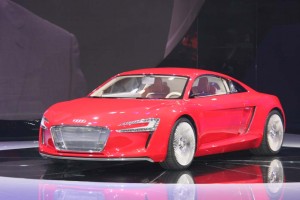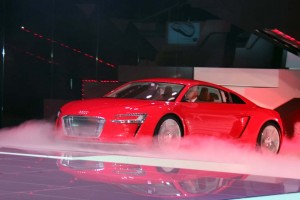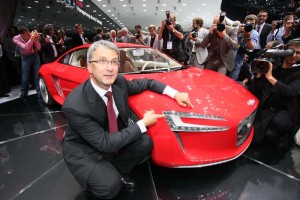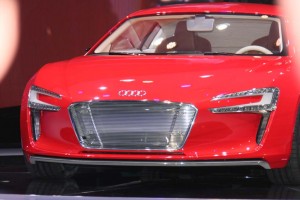
Can a battery vehicle perform like a gasoline-powered supercar? That's what Audi has set out to prove with the 2012 e-tron.
When Audi says, “Charge,” it means it in more ways than one, if the 2012 e-tron is any indication. That’s the German maker’s new battery-electric sports car, a low-slung two-seater that promises to deliver performance to match Audi’s gasoline-powered R8 supercar.
The long-rumored BEV made its debut, Tuesday at the 2009 Frankfurt Motor Show, but expect it to return to the show within the next few years, for senior Audi officials promised to put the e-tron into “serial production” by 2012.
“This is a genuine, high-performance sports car,” said Audi’s global technical chief, Michael Dick, “and not an austerity concept.” The latter comment was a thinly-disguised shot at the Volkswagen luxury division’s competitors, many of whom are also planning battery cars of their own, but ones that will deliver limited range, marginal performance and relatively few conveniences.

The 2012 Audi e-tron promises to launch from 0 - 60 in 4.8 seconds and deliver 140 miles per charge.
At first glance, the 2012 Audi e-tron might be mistaken for the maker’s R8 supercar. It has the same traditional supercar lines, with a long, low hood, a wrap-around cockpit, and what might appear to be a rear-drive layout. In fact, the e-tron is lower and a bit smaller than the R8. Both cars use a spaceframe architecture, but where the R8’s frame is made of aluminum, Audi has gone with a mixture of even lighter-weight aluminum, magnesium and carbon fiber-reinforced plastic on the e-tron.
Weight is everything, when it comes to EVs, stressed Dick, saying the carmaker’s engineers “got down to grams” when deciding which components to use. In total, the battery sports car weighs in at just 1600 kilograms, or 3520 pounds, unusually light for an electric vehicle.

Luxury buyers are more likely to spend money on new technology, like the 2012 Audi e-tron, says the automaker's CEO, Rupert Stadler.
Where most traditional supercars, like the R8, fit their rear-mounted engines, Audi has stuffed in a package of prismatic – or flat – Lithium-Ion batteries, the technology developed by partner Sanyo. The layout, says Dick, provides a sports car-like weight balance and relatively low center of gravity.
In all, there are 53 kilowatt hours of batteries onboard, enough to give the 2012 e-tron 140 miles of range. That’s not quite up to the more than 200 miles per charge claimed by another battery sports car maker, Silicon Valley start-up Tesla Motors, but it’s still better than many other new BEVs coming to market.
Indeed, Audi tech chief Dick made a point of saying that the 140 miles come even when a motorist is using air conditioning, the car’s audio and other current-robbing technology. Most makers rate their range with their vehicles operating in the most optimum situation, with such features turned off and outdoor temperatures of around 70 degrees, which LIon batteries love.

The 2012 Audi e-tron appears to have a lot in common with the maker's R8 supercar, but it actually uses its own, super-light spaceframe, and is lower and smaller than the gasoline-powered supercar.
Charge times would run about 2 hours using a special, 380-volt charging station, and about 10 hours, said Dick, using a standard 220-volt line.
One of the more significant design features of the 2012 Audi e-tron is the BEV’s use of four separate electric motors, one for each wheel. That allows “torque vectoring,” notes Dick. In other words, power can be instantly shifted from one wheel to another to help the sports car blast around corners or deal with inclement weather. In all, the four motors make a combined 313 horsepower. But since electric propulsion generates maximum torque the moment power is applied, the e-tron will yield 0 to 60 times of just 4.8 seconds, in line with the V8-powered R8, and only slightly less than the Tesla Roadster.
“We hope to begin producing a small series of these cars in 2012,” pronounced Dick, later telling TheDetroitBureau.com that the initial production run would be measured in the “tens,” but would rise to “a thousand” or more by 2014, if all goes according to plan.
How much will it cost? Battery technology isn’t cheap, nor are the many technical advancements Audi is building into the 2012 e-tron to enhance range and performance, so sources suggest the BEV supercar would likely come in around, and very probably, at an even higher price point than the R8, which can nudge $160,000 with the new V10 gasoline engine.
But Audi officials say the decision to move so far up-market, as opposed to relatively entry-level battery cars, like the Mini-E, makes sense.
“This is where the customer is most willing to pay a premium for this type of technology,” asserted Audi CEO Rupert Stadler.
As such technology advances and gets into higher volume production, the executive added, “it will move down,” into the mainstream automotive market.
Audi officials say they haven’t decided yet whether to bring the 2012 e-tron to the U.S., but Audi America CEO John de Nysschen said that the company is giving it serious consideration. The States, company officials note, provide makers like Audi with the world’s largest luxury market, but it’s unclear whether American motorists will embrace electric power in large numbers.
